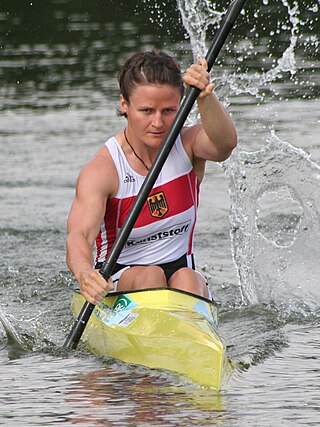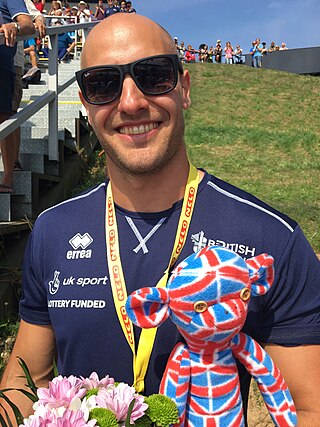
Canoeing is an activity which involves paddling a canoe with a single-bladed paddle. Common meanings of the term are limited to when the canoeing is the central purpose of the activity. Broader meanings include when it is combined with other activities such as canoe camping, or where canoeing is merely a transportation method used to accomplish other activities. Most present-day canoeing is done as or as a part of a sport or recreational activity. In some parts of Europe canoeing refers to both canoeing and kayaking, with a canoe being called an open canoe.

Wildwater canoeing is a competitive discipline of canoeing in which kayaks or canoes are used to negotiate a stretch of river speedily. It is also called "Whitewater racing" or "Downriver racing" to distinguish it from whitewater slalom racing and whitewater rodeo or Freestyle competition.

Canoe slalom is a competitive sport with the aim to navigate a decked canoe or kayak through a course of hanging downstream or upstream gates on river rapids in the fastest time possible. It is one of the two kayak and canoeing disciplines at the Summer Olympics, and is referred to by the International Olympic Committee (IOC) as Canoe/Kayak Slalom. The other Olympic canoeing discipline is canoe sprint. Wildwater canoeing is a non-Olympic paddlesport.
The Royal Canoe Club (RCC), founded in 1866, is the oldest canoe club in the world and received royal patronage in the 19th century. The club promotes canoeing and kayaking, focusing on flatwater, sprint and marathon disciplines. Members of the club have represented Great Britain at World Championships and the Olympic Games. The club is based at Trowlock Island on the River Thames in Teddington near London. The premises are also used by Walbrook Rowing Club, The Skiff Club and Kingston Royals Dragon Boat Racing Club.

A surfski is a type of kayak in the kayaking "family" of paddling craft. It is generally the longest of all kayaks and is a performance oriented kayak designed for speed on open water, most commonly the ocean, although it is well suited to all bodies of water and recreational paddling.

A sprint canoe is a canoe used in International Canoe Federation canoe sprint. It is an open boat propelled by one, two or four paddlers from a kneeling position, using single-bladed paddles. The difficulty of balance can depend on how wide or narrow the canoe is, although regularly the less contact a canoe has with the water the faster it goes. This makes the narrower boats much faster and popular when it comes to racing.
The ICF Canoe Sprint World Championships are an international event in canoe racing, one of two Summer Olympic sport events organized by the International Canoe Federation. The World Championships have taken place every non-Olympic year since 1970 and officially included paracanoe events since 2010; since 2012, paracanoe-specific editions of this event have been held in Summer Paralympic years.

Sprint kayak is a type of canoe sprint held on calm water. The paddler is seated, facing forward, and uses a double-bladed paddle pulling the blade through the water on alternate sides to propel the boat forward. Kayak sprint has been in every summer Olympics since it debuted at the 1936 Summer Olympics. The sport is governed by the International Canoe Federation.
The 2011 ICF Canoe Sprint World Championships was the thirty-ninth edition of the ICF Canoe Sprint World Championships, that took place between 17 and 21 August 2011 in Szeged, Hungary. The Southern Hungarian city welcomed the world event for the third time, having hosted the championship previously in 1998 and 2006. These championships were awarded initially to Vichy, France, however, the race course on the Allier proved to be inadequate to hold the competition and the French Canoe Federation withdraw from organizing the event, following that Szeged, the original host of the 2013 ICF Canoe Sprint World Championships, was moved up to 2011.

Canoe marathon is a paddling sport in which athletes paddle a kayak or canoe over a long distance to the finish line. The International Canoe Federation states standard distance races are at least 10 kilometres (6.2 mi) without an upper limit, while short distance races are between 3.4 kilometres (2.1 mi), and 10 kilometres (6.2 mi). Many events are raced down sections of river, including currents or portages around obstacles. Some events attract thousands of competitors and are staged over several days.

Liam Heath is a British sprint canoeist. He is the most successful British canoeist at the Olympics with a total of four medals; he won a gold medal in the individual 200m kayak sprint event at the 2016 Summer Olympics and a bronze in the 2020 Olympics, as well as a silver in the men's double with Jon Schofield in 2016. and a bronze at the 2012 London Olympics in the K-2 200 with Schofield.

Canoeing – recreational boating activity or paddle sport in which you kneel or sit facing forward in an open or closed-decked canoe, and propel yourself with a single-bladed paddle, under your own power.
Jo Brigden-Jones is an Australian kayaker. She represented Australia at the 2012 Summer Olympics in London and the 2020 Olympic Games in Tokyo in sprint kayaking.

Jon Schofield is a British canoeist. He partnered with Liam Heath in the men's kayak double 200m sprint event, and they have won a bronze in K-2 200 at the 2012 Summer Olympics, and a silver at the 2016 Summer Olympics in the same event. They have also won gold at the European Championships three times as well as silver and bronze medals at the World Championships.

Norwich Canoe Club is based at Whitlingham, Trowse in Norwich, Norfolk, UK with Whitlingham Great Broad, Whitlingham Little Broad, River Yare and River Wensum on its doorstep. It is a canoe and kayak racing club that focuses on flatwater sprint canoeing and marathon canoeing. It is a friendly club where canoeing is safe and fun and welcomes anyone who wants to have a go on the water. The club has as many girls as boys and as many women as men and also many families who all come and paddle together. Members are all ages, from 7 to 70 so there is definitely a place for everyone.
The 2018 ICF Canoe Sprint World Championships, the 44th edition of the World Championships, were held in Montemor-o-Velho, Portugal, from 22 to 26 August 2018.
The 2019 ICF Canoe Sprint World Championships, the 45th edition of the World Championships, were held in Szeged, Hungary from 21 to 25 August 2019.

The women's C-1 200 metres sprint canoeing event at the 2020 Summer Olympics took place on 4 and 5 August 2021 at the Sea Forest Waterway. At least 12 canoeists from at least 12 nations competed.

The women's K-1 200 metres sprint canoeing event at the 2020 Summer Olympics took place on 2 and 3 August 2021 at the Sea Forest Waterway. At least 12 canoeists from at least 12 nations competed.
Jaime Roberts is an Australian canoeist. She qualified to represent Australia at the 2020 Summer Olympics. Her team consisting of Jo Brigden-Jones, Catherine McArthur, and Shannon Reynolds made the women's K-4 final but failed to win a medal, coming 7th with a time of 1:39.797 over two seconds slower than their best time in the heats.





















